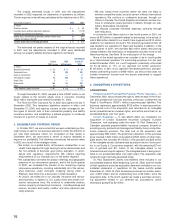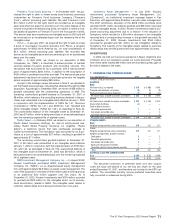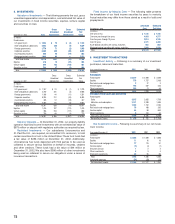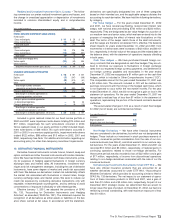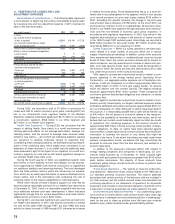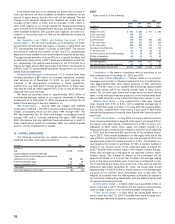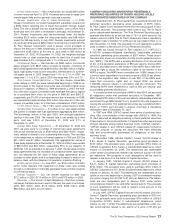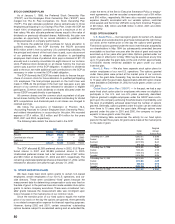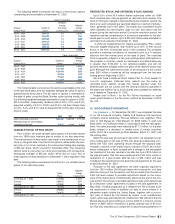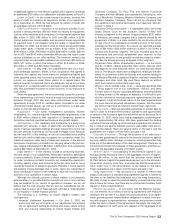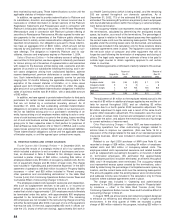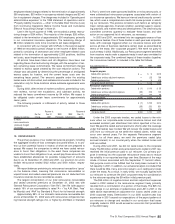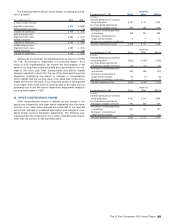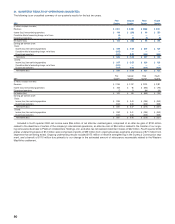Travelers 2002 Annual Report Download - page 82
Download and view the complete annual report
Please find page 82 of the 2002 Travelers annual report below. You can navigate through the pages in the report by either clicking on the pages listed below, or by using the keyword search tool below to find specific information within the annual report.
STOCK OWNERSHIP PLAN
As of January 1, 1998, the Preferred Stock Ownership Plan
(“PSOP”) and the Employee Stock Ownership Plan (“ESOP”) were
merged into The St. Paul Companies, Inc. Stock Ownership Plan
(“SOP”). The plan allocates preferred shares semiannually to those
employees participating in our Savings Plus Plan. Under the SOP, we
match 100% of employees’ contributions up to a maximum of 4% of
their salary. We also allocate preferred shares equal to the value of
dividends on previously allocated shares. Additionally, this plan now
provides an opportunity for an annual allocation to qualified U.S.
employees based on company performance.
To finance the preferred stock purchase for future allocation to
qualified employees, the SOP (formerly the PSOP) borrowed
$150 million at 9.4% from our primary U.S.underwriting subsidiary. As
the principal and interest of the trust’s loan is paid, a pro rata amount
of our preferred stock is released for allocation to participating
employees. Each share of preferred stock pays a dividend of $11.72
annually and is currently convertible into eight shares of our common
stock. Preferred stock dividends on all shares held by the trust are
used to pay a portion of this SOP obligation. In addition to dividends
paid to the trust, we make additional cash contributions to the SOP as
necessary in order to meet the SOP’s debt obligation.
The SOP (formerly the ESOP) borrowed funds to finance the pur-
chase of common stock for future allocation to qualified participating
U.S. employees. The final principal payment on the trust’s loan was
made in 1998. As the principal of the trust loan was paid, a pro rata
amount of our common stock was released for allocation to eligible
participants. Common stock dividends on shares allocated under the
former ESOP are paid directly to participants.
All common shares and the common stock equivalent of all pre-
ferred shares held by the SOP are considered outstanding for diluted
EPS computations and dividends paid on all shares are charged to
retained earnings.
We follow the provisions of Statement of Position 76-3,
“Accounting Practices for Certain Employee Stock Ownership Plans,”
and related interpretations in accounting for this plan. We recorded
expense of $7.4 million, $0.5 million and $14 million for the years
2002, 2001 and 2000, respectively.
The following table details the shares held in the SOP.
December 31 2002 2001
(Shares) Common Preferred Common Preferred
Allocated 4,753,221 524,233 5,144,640 492,252
Committed to be released —35,157 —25,885
Unallocated —171,702 —254,085
Total 4,753,221 731,092 5,144,640 772,222
The SOP allocated 82,383 preferred shares in 2002, 55,578 pre-
ferred shares in 2001 and 83,585 preferred shares in 2000.
Unallocated preferred shares had a fair market value of $47 million
and $90 million at December 31, 2002 and 2001, respectively. The
remaining unallocated preferred shares at December 31, 2002, will be
released for allocation annually through January 31, 2005.
15. STOCK INCENTIVE PLANS
We have made fixed stock option grants to certain U.S.-based
employees, certain employees of our non-U.S. operations, and out-
side directors. These were considered “fixed” grants because the
measurement date for determining compensation costs was fixed on
the date of grant. In the past we have also made variable stock option
grants to certain company executives. These were considered “vari-
able” grants because the measurement date was contingent upon
future increases in the market price of our common stock.
Since the exercise price of our fixed options equals the market
price of our stock on the day the options are granted, there generally
is no related compensation expense for financial reporting purposes.
However, during 2002 and 2001, certain executives’ outstanding
options became subject to accelerated vesting and an extended life,
80
under the terms of the Senior Executive Severance Policy or employ-
ment agreements, and we recorded compensation cost of $4 million
and $16 million, respectively. We have also recorded compensation
expense (benefit) associated with our variable options, restricted
stock awards and the former USF&G’s Long-Term Incentive Program,
of $9 million, $(8) million and $28 million in 2002, 2001 and 2000,
respectively.
FIXED OPTION GRANTS
U.S.-Based Plans — Our fixed option grants for certain U.S.-based
employees and outside directors give these individuals the right to buy
our stock at the market price on the day the options were granted.
Fixed stock options granted under the stock incentive plan adopted by
our shareholders in May 1994 (as subsequently amended) become
exercisable no less than one year after the date of grant and may be
exercised up to ten years after grant date. Options granted under our
option plan in effect prior to May 1994 may be exercised at any time
up to 10 years after the grant date. At the end of 2002, approximately
12,100,000 shares remained available for grant under our stock
incentive plan.
Non-U.S. Plans — We also have separate stock option plans for
certain employees of our non-U.S. operations. The options granted
under these plans were priced at the market price of our common
stock on the grant date. Generally, they can be exercised from three
to 10 years after the grant date. Approximately 260,000 option shares
were available at December 31, 2002 for future grants under our non-
U.S. plans.
Global Stock Option Plan (“GSOP”) — In the past, we had a sep-
arate fixed stock option plan for employees who were not eligible to
participate in the U.S. and non-U.S. plans previously described.
Options granted to eligible employees under the GSOP were contin-
gent upon the company achieving threshold levels of profitability, and
the level of profitability achieved determined the number of options
granted. Generally, options granted under this plan can be exercised
from three to 10 years after the grant date. Although options were
granted under this plan in 2001 and 2000, the company no longer
expects to issue grants under this plan.
The following table summarizes the activity for our fixed option
plans for the last three years.All grants were made at the market price
on the date of grant.
Weighted
Option Average
Shares Exercise Price
Outstanding Jan. 1, 2000 12,062,972 $ 30.96
Granted 6,539,436 33.94
Exercised (3,372,916) 26.42
Canceled (919,110) 36.41
Outstanding Dec. 31, 2000 14,310,382 33.04
Granted 7,333,445 47.29
Exercised (1,545,214) 31.22
Canceled (1,824,580) 38.56
Outstanding Dec. 31, 2001 18,274,033 38.36
Granted 4,410,689 43.49
Exercised (968,813) 29.12
Canceled (2,694,906) 41.18
Outstanding Dec. 31, 2002 19,021,003 $ 39.62


